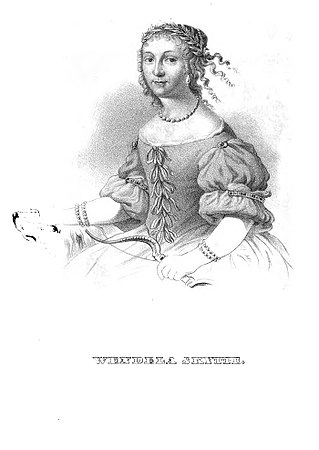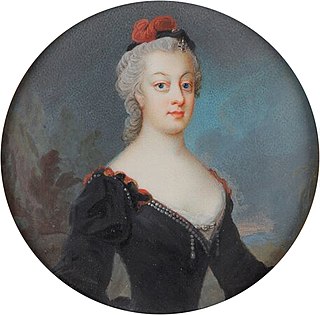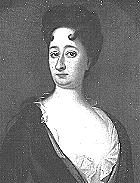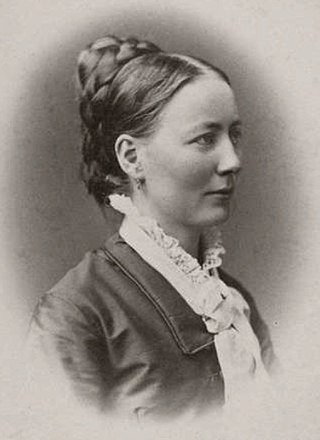Related Research Articles
Margareta Elisabeth Roos or Anna Stina Roos (1696–1772) was a Swedish woman and a crossdresser who served as a soldier in the Swedish army of Charles XII of Sweden during the Great Northern War.
Ingela Olofsdotter Gathenhielm née Hammar, was a Swedish shipowner and privateer in service of King Charles XII of Sweden during the Great Northern War.
Henrika Juliana von Liewen was a Swedish noble, socialite and lady-in-waiting, politically active on behalf of the Hats (party) during the Age of liberty.

Vendela Skytte was a Swedish noblewoman, salonist and writer, poet and Lady of Letters. During her lifetime, she became an ideal and role model for a learned female scholar.

Countess Catherine Charlotte De la Gardie, also known as Catherine Charlotte de La Gardie, was a Swedish countess and courtier. She is famed for her support of the smallpox vaccination in Sweden, and for stopping the last witch trial in her country.
Anna Eriksdotter Bielke was a Swedish noble, commander of the city and castle of Kalmar during the Swedish rebellion against Denmark.

Margareta von Ascheberg was a Swedish land owner, noble and acting regiment colonel during the Great Northern War.

Sofia Lovisa Gumaelius, was a Swedish businessperson.
Valborg Eriksdotter Innamaa was a Finnish merchant and shipowner in Åbo (Turku), Sweden.
Ulrika Fredrika Bremer, née Salonius, was a ship owner and merchant in Swedish Finland. She was the paternal grandmother of Fredrika Bremer. After the death of her husband Jacob Bremer in 1785, at the age of 39, she took over his businesses and ships in Åbo. She successfully managed his business empire over 13 years and was one of the richest Finnish women of her time.
Brigitta Sahlgren, née Ekmarck, was a Swedish businessperson. She was the managing director of the Sahlgrenska sockerbruket in 1736–1771 and a trade- and shipping company in 1736–1744.
Jacob or Jakob Bremer was a Swedish merchant and industrialist.
Lovisa Concordia Simson, née Kliecnik or Lindström, was a Swedish theater director. She was the managing director of the theater Comediehuset in Gothenburg between 1787 and 1792. She was the first female theater director over a permanent theater in her country.
Birgitta Ingvaldsdotter was a Swedish merchant. She belongs to the earliest businesswomen in Sweden about whom there is any significant amount of documentation.

Johanna Brunsson (1846–1920) was a Swedish weaving arts instructor and school founder.
Maria Andersson (1837–1922) was a Swedish textile industrialist and philanthropist.
Lovisa Mathilda Nettelbladt (1814–1867), was a Swedish novelist and travel writer. She wrote under the pseudonym m-n. She lived in the United States between 1850 and 1856, and she is foremost known for her travel book about her life in North America, which belongs to the earliest literature published of a Swedish emigrant as well as a Swedish female emigrant to the USA.
Amalia Redec, was a Swedish pianist and composer. She was a concert pianist and a piano teacher and she produced compositions for piano music in the style of the Romanticism of the 1850s.
Marie-Louise af Forsell or Marie-Louise Forsell, was a Swedish noblewoman diarist. She wrote a diary from the age of sixteen to her death in childbirth at the age of twenty-nine. Her diary was published in four parts by Syster Heijkenskjöld between 1914 and 1917. They became a big success when they were published, and are considered a valuable historical depiction of the everyday conventional life of a Swedish noblewoman in the mid-19th century.
Brita Sigrid Anna Lovisa Egardt was a Swedish ethnologist and folklorist who undertook research into folk beliefs and customs. Attached to the Folklife Archive (Folklivsarkivet) at Lund University, from 1967 to 1973 she was docent of Nordic and comparative folklore research and thereafter docent of ethnology research specializing in folk customs. In addition to her highly rated 1962 thesis Hästslakt och rackarskam, she was a co-editor of Schwedische Volkskunde. Quellen. Forschung. Ergebnisse (1961) and contributed articles on folklore to various journals.
References
- ↑ Sigrid Magdalena Lovisa Björkegren, http://www.skbl.se/sv/artikel/SigridMagdalenaLovisaBjorkegren, Svenskt kvinnobiografiskt lexikon (artikel av Linus Karlsson), hämtad 2020-07-12.